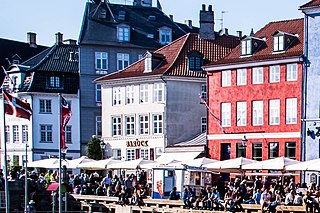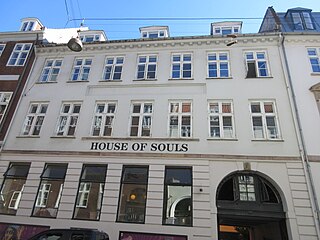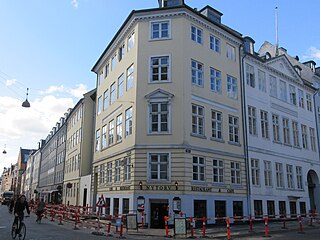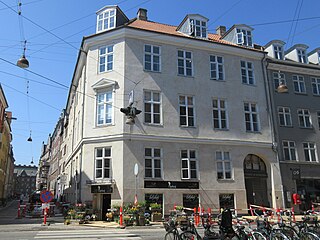
The Jennow House is a historic property located at Strandgade 12 in the Christianshavn neighbourhood of Copenhagen, Denmark. It takes its current name after Andreas Jennow, a businessman who owned it from 1949 to 1978. His company Andreas Jennow A/S was based in the building until 1988.

The Jens Lauritzen House is a Neoclassical property at Nytorv 7 in the Old Town of Copenhagen, Denmark. Home to the Association of Folk High Schools in Denmark, the building is now also known as Højskolernes Hus.

The Krak House is a Neoclassical property overlooking the square Nytorv in the Old Town of in Copenhagen, Denmark. It takes its name from the publishing house Kraks Forlag which was based there for many years. The Danish Centre for Culture and Development, a self-governing institution under the Danish Ministry of Foreign Affairs, is based in the building.

The Rhode House is a historic property located at the corner of Strandgade and Torvegade in the Christianshavn neighbourhood of central Copenhagen, Denmark.

Nyhavn 1 is an 18th-century property at the acute corner of Nyhavn with Store Strandstræde in central Copenhagen, Denmark. It was listed in the Danish registry of protected buildings and places in 1987. Notable former residents include actor and singer Peter Schram (1819–1895).

The Holm House is a listed property located at Gammeltorv 14 in the Old Town of Copenhagen, Denmark. The building was listed on the Danish registry of protected buildings and places in 1926.

The Lars Larsen House is a Neoclassical property located at the corner of Kronprinsessegade and Gothersgade in central Copenhagen, Denmark. It was constructed for ship-builder Lars Larsen shortly after the creation of Kronprinsessegade in the early 1800s. It was listed in the Danish registry of protected buildings and places in 1918. Larsen resided in the building until his death in 1844. Other notable former residents include former chiefs of police Andreas Christian Kierulff and Cosmus Bræstrup.

The Obel House is a Neoclassical property located at Vestergade 2 in the Latin Quarter of Copenhagen, Denmark. It was listed on the Danish registry of protected buildings and places in 1918.

Vestergade 3 is a Neoclassical property in the Old Town of Copenhagen, Denmark. The building was constructed as part of the rebuilding of the city following the Copenhagen Fire of 1795. It was listed in the Danish registry of protected buildings and places in 1959. Notable former residents include the clergy Christian Bastholm and the painters Albert Küchler and Jørgen Roed.

Gammel Strand 40 is a Neoclassical property overlooking Slotsholmen Canal in the Olt Town of Copenhagen, Denmark. The building was listed in the Danish registry of protected buildings and places in 1945. A commemorative plaque above the doorway commemorates that Georg Carstensen, founder of Tivoli Gardens, was a resident in the building when his amusement park opened in 1843. Other notable former residents of Gammel Strand 40 include the archeologist Peter Oluf Brøndsted, writer and editor Jacob Davidsen (1813–1891), songwriter Peter Faber, politician and bishop Ditlev Gothard Monra and journalist Henrik Cacling.d

Nybrogade 24 is an early 19th-century property overlooking the Slotsholmen Canal in central Copenhagen, Denmark. It comprises a four-storey, seven-bays-wide residential building towards the canal and a warehouse at Magstræde 11 on the other side of the block as well as a small courtyard between the two buildings. The entire complex was built in 1815-17 for the wealthy merchant and ship-owner Jørgen Peter Bech, grandfather of the writer Wilhelm Bergsøe who provides an affectionate account of his many visits as a child in his 1898 memoirs De forbistrede drenge. The entire complex was listed in the Danish registry of protected buildings and places in 1918.

Nytorv 15/Rådhusstræde 2 is a Neoclassical property situated at the corner of Nytorv and Rådhusstræde in the Old Town of Copenhagen, Denmark. It consists of two separate buildings, the corner building from 1797 and an eight-bay building from 1798, now connected by a narrow modern infill. The building was listed in the Danish registry of protected buildings and places in 1945. Notable former residents include jurist, writer and publisher Jacob Just Gudenrath (1657–1825), actors Stephan and Eline Heger, theatrical painter Edvard Lehmann and portrait painter hristian Frederik Christensen (1805-1883).

Vestergade 15 is a Neoclassical property situated at the corner of Vestergade and Kattesundet in central Copenhagen, Denmark. The building was listed in the Danish registry of protected buildings and places in 1918. Notable former residents include the Icelandic-Danish lawyer Brynjólfur Pétursson.

Rådhusstræde 6 is a Neoclassical property situated at the corner of Rådhusstræde and Kompagnistræde, betweenGammeltorv-Nytorv and Gammel Strand, in the Old Town of Copenhagen, Denmark. It was constructed by Andreas Hallander, one of the most active master builders in the rebuilding of the city following the Copenhagen Fire of 1795.The building was listed in the Danish registry of protected buildings and places in 1964. Notable former residents include the politicians Johan Nicolai Madvig and J.A. Hansen. Later acquired by the Danish Union of Teachers, it housed the Danish School Museum from 1995 to 2008.

Læderstræde 11 consists of two buildings, a western building from 1806 and an eastern one from 1875 (LæderstrædeA), situated on Strædet, close to Højbro Plads, in the Old Town of Copenhagen, Denmark. Læderstræde 11B was listed in the Danish registry of protected buildings and places in 1939. No. 11A is not heritage listed. Notable former residents include the businessman Louis Meyer for whom the younger of the two buildings was constructed.

The Journalists' House, situated at Gammel Strand 46, opposite Thorvaldsens Museum and Christiansborg Chapel, is the Danish Union of Journalists' headquarters in Copenhagen, Denmark. The Neoclassical building was constructed by Andreas Hallander as part of the rebuilding of the city following the Copenhagen Fire of 1795, incorporating elements from the previous building on the site. It was listed in the Danish registry of protected buildings and places in 1918. Notable former residents include the clergy Christian Bastholm, poet and translator Ditlevine Feddersen, agriculturalist Oluf Christian Olufsen, naval officers Peter Norden Sølling and Carl Irminger, opera director and choir conductor Giuseppe Siboni, court physician Joachim Lund Drejer, ballet master August Bournonville, schoolmistress Natalie Zahle and church historian Carl Joakim Brandt.

Overgaden oven Vandet 54–56 is a complex of Late Neoclassical buildings situated at the corner of Overgaden Oven Vandet and Bådsmandsstræde, adjacent to Søkvæsthuset, in the Christianshavn neighborhood of central Copenhagen, Denmark. The two buildings originate in a two-storey bourgeois townhouse from the first half of the 18th century but were both heightened to five storeys by silk hat manufacturer and developer H.P. Lorentzen in the 1840s. The two buildings were individually listed in the Danish registry of protected buildings and places in 1945.

Brolæggerstræde, also known as J. C. Jacobsens Bryggergård, was the location of Carlsberg-founder J. C. Jacobsen's first breweryin Copenhagen, Denmark. He kept the property after inaugurating his new Carlsberg Brewery in Valby in 1847 and building an extravagant new home next to it in 1854. A commemorative plaque above the gate commemorates that J. C. Jacobsen's son Carl Jacobsen was born in the building in 1842 and that J. C. Jacobsen undertook his first experiments with the brewing of lager beer on the site in 1838. The property comprises a five-storey brewery building in the courtyard as well as a four-storey apartment building and a former warehouse around the corner at Knabrostræde 11–13. The entire complex was constructed as part of the rebuilding of the city following the Copenhagen Fire of 1795. It was listed in the Danish registry of protected buildings and places in 1945. The property is now owned by the Carlsberg Foundation and the Ny Carlsberg Foundation is based in the brewery building in the courtyard. Other notable former residents include the writer Thomas Christopher Bruun, composer Friedrich Ludwig Æmilius Kunzen, theologian Jens Møller and architect Johan Daniel Herholdt. The adjacent corner building Knabrostræde 9 was also listed in 1045 and is also owned by the Carlsberg Foundation. A commemorative plaque on the chamfered corner commemoraties that J. C. Jacobsen was born in the building in 1811.

Kompagnistræde 20 is a Neoclassical building complex situated at the corner of Kompagnistræde and Knabrostræde in the Old Town of Copenhagen, Denmark, constructed in 1796–97 as part of the rebuilding of the city following the Copenhagen Fire of 1795. A brewery was for more than 200 years, from at least the late 1640s until the 1860s, operated on the site. The building complex comprises a residential corner building as well as an adjacent warehouse at Knabrostræde 16 and another warehouse in the courtyard. The entire complex was listed in the Danish registry of protected buildings and places in 1945. Notable former residents include the government official Jacob Gude, civil servant and later Minister of Interior Affairs I.J. Unsgaard and painter and photographer Edvard Valdemar Harboe.

Østergade 13 is a Historicist building complex situated on the shopping street Strøget in central Copenhagen, Denmark. Originally two separate 18th-century buildings, three and four bays wide, respectively, Østergade 13 owes its current appearance to a renovation in 1856. Lille Kongensgade 12–14 on the other side of the block is also part of the property. Carl Antonelli's plaster workshop—known for its reproductions of many of Bertel Thorvaldsen's works—was based on the site from c. 1820 to 1854. Kunstforeningen was also based in the building from 1834 to 1854. Other notable former residents include the educator Carl Mariboe, economist and writer Oluf Christian Olufsen (1764–1827) and businessman Isaac Wulff Heyman. The property is today owned by Odense-based Barfoed Group.


























